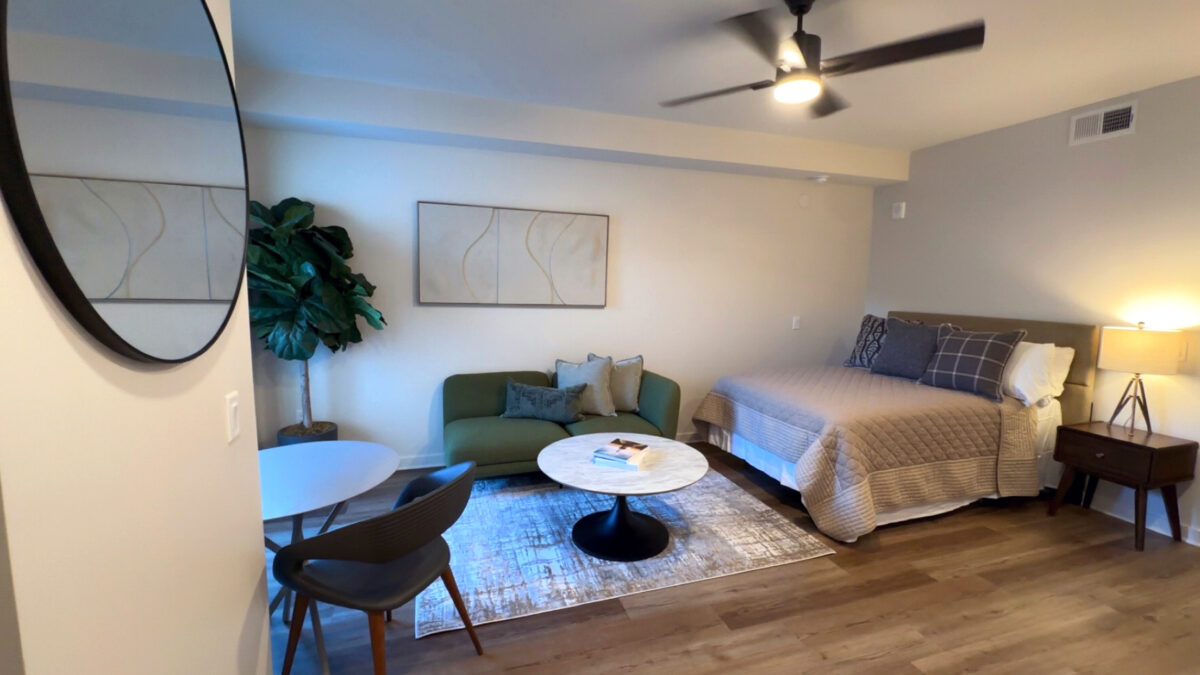About 3.5 years ago, I met Angelica while she was working in the housing department at a private art college. I was immediately intrigued by her passion for Higher Education, as well as her drive and work ethic. As a UCLA graduate who worked to personally finance 100% of her education, I knew we had the same values and personal drive in common.
For a little history of Angelica’s background, she currently works in Higher Education as a Residential Life professional and First-Year Experience Manager. This work has given her firsthand knowledge on the topic of mental health on college campuses.
With the changes in the education system over the last year, I felt it was essential to get a viewpoint from a Higher Education professional on what campuses are doing to improve the virtual experience, affect students, and move forward with returning to on-campus learning. Enjoy!
FG: Will you please tell our audience a bit about your background in Higher-Ed, the role of a First-Year manager, and why your position has been created at Columbia College?
AR: My Higher Education career began 14 years ago. Following my graduation from UCLA, where I had served as a Resident Advisor in Student Housing for three years, I took a role with Paul Smith’s College, a small private College in Upstate New York. I was their Residential Life Coordinator and Assistant for the college’s at-risk student retention program.
Currently, I am in Student Affairs as the First-Year Experience Manager at Columbia College Hollywood in Los Angeles, CA. My role was created specifically as part of the college’s student Retention Initiative and ongoing efforts to provide localized support directly to students in their first academic year.
I serve as one of the first contact points to all students, particularly first-year students, and meet regularly with those deemed “at-risk” academically upon acceptance to the college. I work with students to create Academic Success Plans and offer them support and accountability as they navigate their first quarter and academic year of college. In support of this, I also sit on our College’s At-Risk Students and Retention Committee.
FG: In your role, you work with students weekly as part of the curriculum toward graduation; how has instruction changed over the last 12 months, and what new routines are you seeing among your students?
AR: Like at Colleges and Universities everywhere, instruction has adapted rapidly to the move to using virtual platforms for teaching due to the pandemic. Instructors and students equally are navigating these changes and have exhibited the necessary flexibility to continue offering and receiving instruction for our Institution’s academic programs.
Overall, there has been an acknowledgment of the previously unknown benefits of remote instruction. We see both positive and negative habits from our student body to these changes. On the one hand, I am incredibly impressed with how understanding and flexible our students have been in adjusting to this new way of learning while staying committed to pursuing their academic endeavors. Unfortunately, we are seeing some interesting behaviors from several students that are a direct result of not having a clear separation between the school environment and home environment.
For example, some students log into their virtual classrooms from their bedrooms, sometimes while in bed, not preparing appropriately to be present in class. They face the additional distractions of sharing their learning spaces with family members, and some find it challenging to focus on school when all the creature comforts of home are right next to them.
FG: What feedback have you received from students about virtual learning and its success? How is the retention with the students?
AR: Our school is unique in that, as a film school, our on-campus education strategies are heavily centered around providing hands-on learning opportunities to students. In many cases, this is not currently possible as our campus has temporarily closed during the pandemic. Yet, I have received overwhelmingly positive feedback from students nevertheless.
There is a general consensus amongst students that although remote learning is not their desired means of instruction, they still find a lot of value in their education. The feedback that we have received shows that students enjoy their classes and the opportunities for interaction and virtual connection with their peers and staff. The feeling is that the quality of their education continues to reinforce their beliefs that attending school during the pandemic is the right choice for them and that they feel supported in pursuing their long-term career goals.
Simultaneously, many students are understandably having some trouble adjusting to this new way of learning. Many students appreciate the accountability of physically going to class and feeling a stronger sense of support by being in a physical classroom with other students where they can more readily engage with others.
FG: That makes a lot of sense and flattering to hear that students are giving feedback around what works best for them; so, you and your team can help them accomplish their academic goals. Transitioning topics, a little bit, what concerns do you have about the longer-term effects of virtual learning on student’s mental health?
AR: I mentioned earlier that one of the challenges of virtual learning is that many students are no longer experiencing a clear, distinct separation from home and school. As such, students potentially risk having a more challenging time separating academic expectations and commitments from those related to their immediate living environment.
Similar to how those of us in the professional world strive for a healthy work-life balance, students also need to understand this conceptually and live it in practice. Practicing effective self-care and balancing priorities is paramount to wellness. Students can become overwhelmed if they are not implementing the proper procedures necessary to create a healthy home life and work life.
FG: How has your faculty and staff been trained and prepared to adjust to offering courses and support via the virtual learning model?
AR: Because the transition was relatively sudden, staff and faculty have done a fantastic job of adjusting and adhering to this new way of conducting instruction and offering student support with little prior training. Our IT department has also been instrumental in assisting with challenges that arise for technology. Everyone has supported one another and has acknowledged the variations in each other’s learning curves and comfort level utilizing technology.
FG: The value of relationships and human interaction is essential now more than ever. Based on my personal experience, connecting with colleagues and leadership weekly has personally helped me. Our connection time can be as simple as a few minutes to see how our weekends went or discuss a project we are working on.What is your campus doing to create a more engaging environment in a virtual world?
AR: On our campus, there has been a strong push for students to create opportunities to connect through virtual platforms and social media. That the pandemic has required us to quarantine and limit our physical interactions with one another does not negate the fact that we have an innate need and desire to connect with others as humans. A lot of the quality of a student’s college experience is shaped by their interactions with their peers and their level of involvement with their campus community. These interactions must continue in a meaningful way for students to have the best possible college experience available to them.
Additionally, I am very fortunate that our college recognized the need for students, particularly those in their first year, to have a dedicated staff member who interacts with them directly, offers support and guidance, and prioritizing their success. This is the essence of my role, and we see obvious benefits to our overall retention efforts as a result.
FG: Congratulations on your new role. That speaks volumes about Columbia College Hollywood and the value they see in your skills and the importance of having a full-time staff member for first-year students to engage with. What are some of the new initiatives that schools should have to best support students’ mental health?
AR: Campuses must emphasize that support services are available to students. Students are strongly encouraged to reach out and utilize their support networks as they are needed. Equally, I believe that now more than ever is a time for campuses to make concerted efforts to focus on direct and one-on-one support for students that may not have existed before the pandemic. New initiatives might involve connecting students with outside resources available to them through the Institution, such as connecting students to mental health support services available in local communities outside of campus. Equally, fostering student engagement through social media platforms and programs can be beneficial to students in a very impactful and profound way.
FG: With all of your housing experience, what have you learned about the importance of students creating a living space to call “home” while in college? How important are aesthetics and furniture as part of this space?
AR: We often speak in Higher Education about the importance of “safe spaces” for students both physically and theoretically on-campus. For most, having a stable, safe, and secure living environment is crucial to a student’s academic and holistic success. Furthermore, a student’s living environment should feel like “home” and offers a comfort level that presents a welcome environment that they expect when they are in any other place that they would call home.
Aesthetics play a huge role in this, especially for college students living in a Residence Hall or apartment while away from family. Students like to hang pictures or posters on the wall. They enjoy being surrounded by artwork and having a space reflecting who they are and their interests in its décor. Furniture equally plays a significant role in the creation of this feeling of home.
For students, the furniture they use must be present, comfortable, in proper working order, look as new as possible, and up to date and on-trend.
Often, students and families take tours of Residence Halls and apartments before agreeing to participate in a student housing program. What they SEE determines how they feel about a place before they will ever live in it.
The furniture and its layout set the tone for the kind of lived experience the student will expect to have in a given environment.
FG: Well said, and I can’t agree with you more! I have the pleasure of delivering furniture to many college campuses in Southern CA; parents give me feedback that “the furniture CORT just delivered for their child is so nice, and we helped transform their new space into a home for them.” Hearing that feedback always puts a smile on my face. Before I let you go, I have one more question: What do you see as the positive aspects of the last 12 months? Will we ever go back to the traditional college campus, life as we knew it in 2019? :
AR: I believe that one of the most positive takeaways from this past year is recognizing and acknowledging just how adaptable we can become under pressure. With hard work and buy-in from all areas of campus, we can successfully achieve any new initiatives and adapt to any changes as they are implemented.
I do believe that we will go back to the traditional college campus life as it once was. Still, I think moving forward, education will be conducted much more thoughtfully, intentionally, and in a much more sustainable way.
We will think critically about how we use our resources. I hope that we will sharply reconsider what work-life balance looks like for students and employees and what reasonable accommodations and changes can be made to ensure that everyone can work to their highest competency levels.
About Angelica
Angelica Robinson is an Educator in the field of Higher Education with over eleven years of experience in the areas of Student Affairs and Housing and Residential Life. She currently works at Columbia College Hollywood in Los Angeles, CA where she focuses her efforts on promoting the success and retention of First-Year students. Her core competencies include working with vision, values, and integrity, and exceeding set, measurable goals. She is equally passionate about her work in social justice advocacy and promotes diversity awareness through education.
About Fran:
Fran Garfinkel Greenstein is responsible for educating, partnering, and building relationships with the Higher Education and Military markets in Southern CA to support CORT’s specialized initiatives. Fran brings her expertise and years of experience to every situation she is engaged in. An enthusiastic leader that has earned a reputation of being a trustworthy business partner for her customers. Follow Fran on Linkedin for more tips and ideas for Higher Ed.





